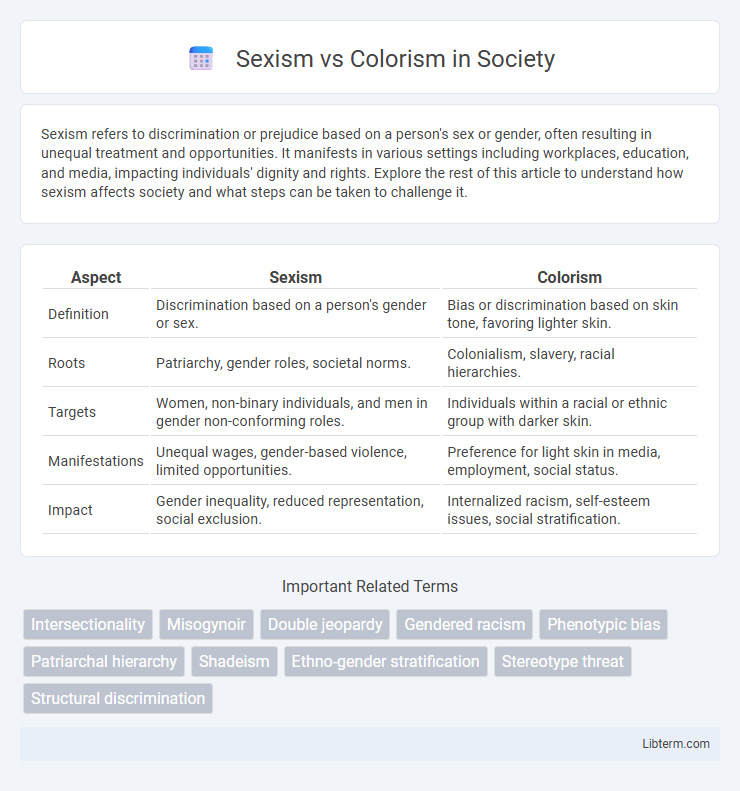Sexism refers to discrimination or prejudice based on a person's sex or gender, often resulting in unequal treatment and opportunities. It manifests in various settings including workplaces, education, and media, impacting individuals' dignity and rights. Explore the rest of this article to understand how sexism affects society and what steps can be taken to challenge it.
Table of Comparison
| Aspect | Sexism | Colorism |
|---|---|---|
| Definition | Discrimination based on a person's gender or sex. | Bias or discrimination based on skin tone, favoring lighter skin. |
| Roots | Patriarchy, gender roles, societal norms. | Colonialism, slavery, racial hierarchies. |
| Targets | Women, non-binary individuals, and men in gender non-conforming roles. | Individuals within a racial or ethnic group with darker skin. |
| Manifestations | Unequal wages, gender-based violence, limited opportunities. | Preference for light skin in media, employment, social status. |
| Impact | Gender inequality, reduced representation, social exclusion. | Internalized racism, self-esteem issues, social stratification. |
Understanding Sexism and Colorism: Key Definitions
Sexism refers to discrimination or prejudice based on a person's gender, often manifesting as unequal treatment of women and men in social, economic, and political contexts. Colorism is a form of prejudice or discrimination favoring individuals with lighter skin tones within the same racial or ethnic group, affecting access to opportunities and social acceptance. Both sexism and colorism perpetuate systemic inequality by reinforcing harmful stereotypes and social hierarchies related to gender and skin color.
Historical Origins of Sexism and Colorism
Sexism traces its origins to ancient patriarchal societies where male dominance structured political, economic, and social hierarchies, reinforcing gender inequality through laws and cultural norms. Colorism emerged from colonial and slavery-era contexts, where lighter skin was associated with higher social status and proximity to colonial rulers, creating entrenched discrimination within racial groups. Both systems function to maintain power hierarchies by privileging certain identities--men and lighter-skinned individuals--over others.
Manifestations of Sexism Across Cultures
Manifestations of sexism across cultures vary widely, encompassing wage gaps, gender-based violence, and unequal educational opportunities, often rooted in deeply entrenched patriarchal norms. In many societies, sexist practices are institutionalized through legal frameworks, social customs, and media representation, reinforcing gender stereotypes that limit women's roles both publicly and privately. Cross-cultural analysis reveals that while the forms of sexism may differ, the underlying mechanisms of power imbalance and discrimination consistently marginalize women and impede gender equality worldwide.
Colorism: A Global Issue Beyond Skin Tone
Colorism, a pervasive global issue, transcends mere skin tone differences, deeply impacting social, economic, and cultural dynamics across various societies. Unlike sexism, which primarily targets gender-based discrimination, colorism affects individuals within the same racial or ethnic group, creating hierarchies based on skin pigmentation. Its influence extends to opportunities in education, employment, and media representation, perpetuating inequality and marginalization worldwide.
Intersectionality: Where Sexism and Colorism Meet
Sexism and colorism intersect to create unique forms of discrimination that disproportionately affect women of color, amplifying the challenges they face in social, economic, and political realms. Intersectionality reveals how sexist biases often intertwine with colorist prejudices, leading to compounded marginalization in areas such as employment, healthcare, and media representation. Understanding this intersection helps address the nuanced experiences of those impacted by multiple, overlapping systems of oppression.
Media Representation: Shaping Perceptions of Gender and Skin Tone
Media representation significantly influences societal attitudes toward sexism and colorism by perpetuating gender stereotypes and preferentially highlighting lighter skin tones, reinforcing harmful biases. Films, advertisements, and television often portray women in limited, objectified roles while consistently favoring fair-skinned characters, thereby marginalizing darker-skinned individuals and restricting gender diversity. This selective visibility shapes public perceptions, normalizing discrimination based on both gender and skin color, and underscores the need for more inclusive and equitable media portrayals.
Economic and Social Impacts of Sexism and Colorism
Sexism perpetuates wage gaps, limiting women's economic opportunities and contributing to poverty rates that disproportionately affect female-headed households. Colorism exacerbates social inequalities by restricting access to education, employment, and social mobility for individuals with darker skin tones, reinforcing economic disparities within communities of color. Both forms of discrimination deepen systemic barriers, resulting in reduced income, limited career advancement, and heightened social exclusion.
Personal Narratives: Lived Experiences of Discrimination
Personal narratives reveal how sexism and colorism uniquely shape individual experiences of discrimination, highlighting the intersectionality of gender and skin tone biases. Women of color often recount compounded prejudices where sexist attitudes intersect with colorist judgments, affecting their social, professional, and emotional well-being. These lived experiences emphasize the importance of recognizing how overlapping forms of discrimination create complex barriers that are not addressed by tackling sexism or colorism in isolation.
Combatting Sexism and Colorism: Solutions and Advocacy
Combatting sexism and colorism requires comprehensive advocacy focused on education, policy reform, and community engagement to dismantle deep-rooted biases. Promoting inclusivity through intersectional awareness campaigns and implementing anti-discrimination laws targeting both gender and skin tone prejudices are critical steps. Empowering marginalized groups with resources and amplifying diverse voices in media, workplaces, and legislation fosters systemic change against sexism and colorism.
The Future of Equity: Moving Beyond Sexism and Colorism
The future of equity demands dismantling both sexism and colorism to create truly inclusive societies where opportunities are not limited by gender or skin tone. Advancing legal frameworks, educational reforms, and corporate diversity initiatives must integrate intersectional approaches that simultaneously address gender and color biases. Empowering marginalized voices and fostering cultural awareness are key to nurturing a comprehensive equity landscape beyond the traditional confines of sexism and colorism.
Sexism Infographic

 libterm.com
libterm.com